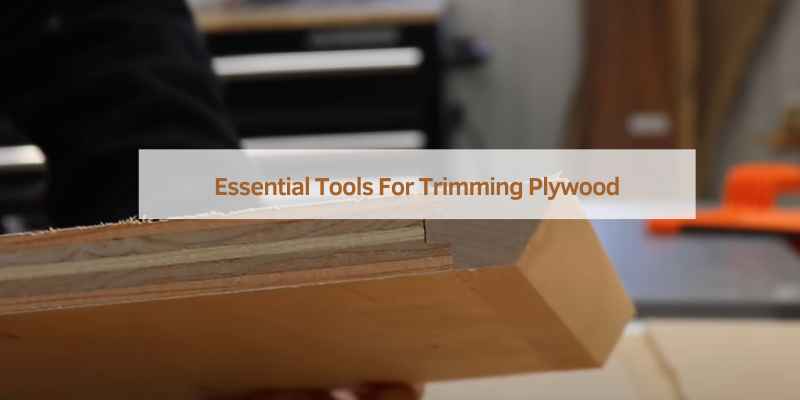To trim plywood, use a circular saw with a fine-tooth blade. Measure and mark the cut line accurately.
Trimming plywood is a common task in woodworking projects. Whether you are building furniture, cabinets, or shelving units, knowing how to trim plywood properly is essential for achieving precise and clean cuts. Using the right tools and techniques can make this process much easier and ensure that your project turns out exactly as planned.
In this blog post, we will discuss the steps and methods for trimming plywood effectively, so you can tackle your next woodworking project with confidence.
Essential Tools For Trimming Plywood
When it comes to trimming plywood, having the right tools is essential for achieving accurate cuts and a professional finish. Whether you’re working on a DIY project or a professional woodworking job, the right tools can make all the difference in the quality of your work. In this section, we’ll explore the essential tools needed for trimming plywood, including selecting the right saw, measuring tools for accurate cuts, and the importance of clamps and straight edges.
Selecting The Right Saw
When it comes to cutting plywood, having the right saw is crucial. A circular saw with a fine-toothed blade is ideal for making straight cuts, while a jigsaw is perfect for curved or intricate cuts. Ensure the saw blade is sharp for clean and precise cuts.
Measuring Tools For Accurate Cuts
Accurate measurements are key to achieving precise cuts. Utilize a tape measure for length and width measurements, and a combination square for ensuring straight cuts. Additionally, a speed square can be handy for marking and making angled cuts.
Clamps And Straight Edges
Securing the plywood in place is essential for safe and accurate cutting. Clamps help to hold the plywood steady, while straight edges ensure your cuts are straight and true. A straight edge guide can be used with a circular saw for perfectly straight cuts.

Preparing Your Workspace
Before diving into the task of trimming plywood, it’s crucial to prepare your workspace to ensure a safe and efficient working environment. This involves taking necessary safety precautions and setting up a stable work surface to guarantee precise and accurate cuts. Let’s delve into the essential steps for preparing your workspace.
Safety First: Gear And Precautions
When operating power tools, safeguarding yourself with the right gear and adhering to safety precautions is paramount. Wear protective goggles, ear defenders, and a dust mask to shield yourself from flying debris and noise. Additionally, avoid loose clothing and jewelry that could get caught in the machinery.
Setting Up A Stable Work Surface
To ensure stability and accuracy when trimming plywood, it’s crucial to set up a stable work surface. Begin by securing the plywood firmly to a sawhorse or workbench using clamps. This prevents the material from moving during the cutting process, ensuring clean and precise cuts.
Measuring And Marking Plywood
To trim plywood accurately, start by measuring and marking it precisely using a straight edge and a pencil. Ensure the lines are clear before cutting along them for a clean finish. This method helps achieve straight cuts and reduces the risk of errors in your woodworking projects.
Understanding Plywood Dimensions
Before cutting plywood, it’s essential to have a clear understanding of its dimensions. Plywood comes in standard sheets of 4 feet by 8 feet, and the thickness can range from 1/8 inch to 3/4 inch. However, it’s crucial to note that the actual thickness may vary slightly due to sanding. For instance, a 3/4 inch plywood sheet may measure slightly less than that once it’s sanded.
Techniques For Precise Marking
Precise marking is crucial when it comes to cutting plywood. Here are some techniques to ensure accuracy:
- Measure Twice: It’s essential to double-check your measurements before marking the plywood. Ensure that you have the correct dimensions before you start marking.
- Use a Straight Edge: A straight edge, such as a ruler or a carpenter’s square, can help you make straight and accurate marks.
- Mark with a Pencil: A pencil mark is easy to see and can be erased if you need to make changes. Avoid using pens or markers as they can bleed into the wood grain and make it challenging to get a precise cut.
- Use a Utility Knife: A utility knife can help you score the plywood along the marked line. This scoring will prevent the plywood from splintering when you make the final cut.
- Label the Pieces: If you’re cutting multiple pieces of plywood, it’s essential to label each piece to avoid confusion. You can use a piece of tape or write directly on the plywood to label each piece.
Measuring and marking plywood accurately is essential for getting the best results. By understanding the dimensions of plywood, using the right tools and techniques, and double-checking your measurements, you can ensure that your plywood cuts are precise and clean.
Straight Cuts: The Basic Technique
Guiding The Saw For Perfect Straight Edges
Position the saw guide firmly against the plywood for accurate cuts.
Troubleshooting Common Issues
Address any saw blade drift by adjusting your cutting technique.
Circular Saw Mastery
Mastering the use of a circular saw is essential when it comes to trimming plywood efficiently and accurately. By understanding how to set the blade depth, support the plywood during cuts, and handle the saw with precision, you can achieve professional results with ease.
Setting Blade Depth
Adjust the blade depth to match the thickness of the plywood to avoid cutting too deep.
Supporting Plywood During Cuts
Use sawhorses or a sturdy workbench to support the plywood and prevent splintering.
Jigsaw For Curved Cuts
To trim plywood with curved cuts, a jigsaw is the ideal tool. Its ability to make intricate cuts makes it perfect for shaping plywood to fit any design. With the right blade, a jigsaw can easily slice through the wood, creating smooth curves and angles.
If you’re looking to add curves to your plywood project, a jigsaw is the perfect tool for the job. With a jigsaw, you can easily make both tight and gentle curves with precision and control. However, to ensure a successful cut, you need to choose the right blade and know how to navigate tight corners.
Choosing The Right Blade
When it comes to cutting plywood with a jigsaw, the type of blade you use is crucial. A blade with fewer teeth per inch (TPI) will be faster but leave a rougher finish. On the other hand, a blade with more TPI will be slower but result in a smoother cut. For plywood, a blade with around 10 TPI is a good choice.
Navigating Tight Curves And Corners
To navigate tight corners, you’ll need to make relief cuts. These are small cuts made near the corners that allow the blade to turn without binding. To make a relief cut, start by drilling a small hole in the waste area, then insert the blade and cut to the corner. From there, pivot the blade and continue cutting along the curve.
When making gentle curves, it’s important to keep the blade moving smoothly and at a consistent speed. Avoid stopping and starting, as this can result in jagged cuts. Instead, move the jigsaw slowly and steadily along the curve.
With the right blade and technique, a jigsaw can be a powerful tool for cutting curves in plywood. By following these tips, you can achieve precise, smooth cuts that add a professional finish to your project.
Finishing Touches
When it comes to trimming plywood, the finishing touches are essential to achieve a polished and professional result. These final steps will not only enhance the appearance of your project but also ensure its longevity. In this section, we will discuss two crucial finishing touches: sanding edges for smoothness and sealing and protecting cut edges.
Sanding Edges For Smoothness
Before proceeding with any further steps, it is important to sand the edges of your plywood to achieve a smooth and even surface. Sanding helps remove any roughness or splinters, ensuring a clean and professional finish. Follow these steps to sand the edges effectively:
- Start by using a coarse-grit sandpaper, such as 80-grit, to remove any large imperfections or rough areas on the edges.
- Hold the sandpaper firmly and move it along the edges in a smooth, consistent motion. Apply even pressure to ensure an even sanding.
- Once you have finished sanding with the coarse-grit sandpaper, switch to a finer-grit sandpaper, such as 120-grit or higher, to further smooth the edges.
- Repeat the sanding process with the finer-grit sandpaper, paying attention to any remaining rough spots or uneven areas.
- After sanding, wipe away any dust or debris from the edges using a clean cloth or a tack cloth.
Sealing And Protecting Cut Edges
Sealing and protecting the cut edges of plywood is crucial to prevent moisture absorption, warping, and damage over time. Here are the steps to effectively seal and protect the cut edges:
- Start by cleaning the cut edges of any dust or debris using a clean cloth or a tack cloth.
- Apply a wood sealer or primer to the cut edges using a brush or a foam applicator. Make sure to cover the entire surface evenly.
- Allow the sealer or primer to dry completely according to the manufacturer’s instructions.
- Once the sealer or primer has dried, sand the edges lightly with a fine-grit sandpaper to achieve a smooth finish.
- After sanding, wipe away any dust or debris from the edges using a clean cloth or a tack cloth.
- Finally, apply a coat of paint, stain, or finish to the cut edges to provide additional protection and enhance the overall appearance.
By following these finishing touches, you can ensure that your plywood project not only looks great but also withstands the test of time. Sanding the edges for smoothness and sealing and protecting the cut edges are essential steps that should not be overlooked. Take the time to complete these final touches, and you will be rewarded with a high-quality, professional result.
Advanced Techniques And Tips
When it comes to trimming plywood, advanced techniques and tips can help you achieve precise cuts and avoid common issues like splintering and tear-out. In this section, we will explore two important aspects of plywood trimming: handling large sheets solo and mitigating splintering and tear-out.
Handling Large Sheets Solo
Trimming large plywood sheets on your own can be challenging, but with the right approach, it is definitely achievable. Here are some techniques to handle large sheets solo:
- Prepare your workspace: Clear any clutter and ensure you have enough space to maneuver the plywood sheet.
- Support the sheet: Use sawhorses or a sturdy workbench to support the plywood. Make sure the sheet is evenly supported along its length.
- Secure the sheet: Use clamps or weights to secure the plywood sheet in place, preventing it from shifting during cutting.
- Use a guide: A straightedge or a guide rail can help you maintain a straight cutting line. Clamp the guide in place and run your saw along it for precise cuts.
- Take breaks if needed: Trimming large sheets can be physically demanding. Take breaks to rest and avoid fatigue, ensuring your safety and accuracy.
Mitigating Splintering And Tear-out
Splintering and tear-out are common issues when cutting plywood, but there are techniques you can use to minimize or eliminate them:
- Choose the right blade: A high-quality plywood cutting blade with fine teeth can reduce splintering and tear-out.
- Score the cut: Before making the full cut, use a utility knife or a scoring tool to create a shallow groove along the cutting line. This can help prevent splintering.
- Support the cut: Place a sacrificial backing, such as a scrap piece of plywood, behind the area where you will make the cut. This can provide support and minimize tear-out.
- Control the feed rate: Push the plywood steadily and smoothly through the saw, avoiding excessive force or speed that can lead to splintering and tear-out.
- Use masking tape: Applying masking tape along the cutting line can help reduce splintering, as the tape provides support and prevents the wood fibers from tearing.
By following these advanced techniques and tips, you can confidently trim plywood with precision and minimize the chances of splintering and tear-out. Remember to prioritize safety and take your time to achieve the best results.
Cleaning Up And Maintenance
After you have successfully cut your plywood, it’s important to clean up and maintain your tools to ensure their longevity and safe usage. Proper disposal of plywood offcuts and tool care after cutting are essential components of cleaning up and maintenance.
Proper Disposal Of Plywood Offcuts
Disposing of plywood offcuts properly is important for safety and environmental reasons. Here are some tips for disposing of plywood offcuts:
- Check with your local waste management facility to see if they accept plywood offcuts for disposal.
- If not, consider using the plywood offcuts for other projects or donating them to a local organization.
- Never burn plywood offcuts as they can release harmful chemicals into the air.
Tool Care After Cutting
Proper tool care after cutting is essential for maintaining their performance and longevity. Here are some tips for tool care after cutting:
- Remove sawdust and debris from your tools with a brush or compressed air.
- Apply a protective oil or lubricant to prevent rust and corrosion.
- Store your tools in a dry and secure location to avoid damage or theft.
By following these tips for cleaning up and maintenance, you can extend the life of your tools and contribute to a safer and cleaner environment.
Creative Projects With Trimmed Plywood
Looking to add a touch of creativity to your space? Trimmed plywood can be the perfect material for a variety of DIY projects. From home decor to functional furniture, there are endless possibilities to explore.
Diy Home Decor Ideas
Transform your living space with these simple DIY home decor projects using trimmed plywood:
- Create modern wall art using geometric plywood shapes.
- Design a minimalist floating shelf for a sleek look.
- Craft a unique plant stand to bring greenery indoors.
Building Functional Furniture
Elevate your space with customized furniture pieces made from trimmed plywood:
- Build a sturdy bookshelf for your favorite reads.
- Construct a versatile coffee table with hidden storage.
- Craft a stylish desk that fits your space perfectly.

Frequently Asked Questions
How Do You Trim Plywood Without Splintering?
To trim plywood without splintering, use a sharp, fine-toothed blade on a circular saw or a table saw. Ensure that the plywood is firmly supported and use a slow, steady cutting motion. Applying masking tape along the cut line can also help prevent splintering.
Can I Use A Jigsaw To Trim Plywood?
Yes, a jigsaw can be used to trim plywood. Use a fine-toothed blade and set the jigsaw to a medium speed. Ensure that the plywood is adequately supported to minimize vibration and use a slow, steady cutting motion for cleaner cuts.
What Is The Best Tool To Trim Plywood?
The best tool to trim plywood is a circular saw or a table saw. These tools provide clean and precise cuts due to their sharp blades and stability. A track saw is also a great option as it offers straight and accurate cuts, especially for longer pieces of plywood.
How Can I Prevent Tearout When Trimming Plywood?
To prevent tearout when trimming plywood, use a sharp blade with fine teeth. Adjust the cutting depth of your saw to slightly deeper than the thickness of the plywood. Additionally, scoring the cut line with a utility knife before using the saw can help reduce tearout.
Conclusion
Mastering the art of trimming plywood is an essential skill for any DIY enthusiast. By following the correct techniques and using the right tools, you can achieve precise and professional results. Whether it’s for home renovations or woodworking projects, the ability to trim plywood effectively will elevate the quality of your work.


